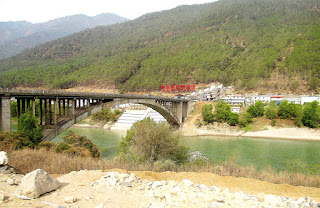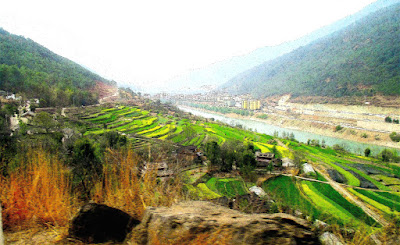 |
| oldest stone bridge in Shuhe |
 |
| cobblestone streets parallel the crystal clear canal |
Unlike the relatively simple grid
pattern of the street layout in Dali, Shuhe, although smaller, has a
more complexly convoluted street pattern and takes more getting used
to finding your way around. There are many lovely clear canals
gurgling through town from a spring source to the north. We strolled northward along the cobblestone streets and lanes that parallel the main stream towards a
source spring. Spring (the season) was bursting out all over Shuhe
now, and the greening of the town was becoming unmistakable.
 |
| the center of Shuhe surrounds a large pool of clear spring water |
 |
| The Source of the Shuhe waterways. |
 |
| Spring at the spring |
There turned out to be a worm in the
apple, however. In that nearly idyllic Spring/spring setting we got scammed—by a “Buddhist monk” of all
things. He was a bald largish man in yellow robes and very friendly,
nodding and smiling and talkative—a mile a minute in Chinese to
Road Buddy thinking, as most people do, that she is Chinese.
Obviously (or intentionally) oblivious to the fact that he was
getting no positive feedback he casually pulled what looked like a
bead necklace from somewhere inside his robes and put it around her
neck and then slipped a wooden bead bracelet on my wrist. Still
smiling broadly he made the sign for money (rubbing the thumb and
first and second fingers rapidly to indicate counting money). At
first I thought he was showing us how to use “prayer beads” and
nodded and smiled and thanked him and made to walk off. But he
stopped us and made the thumb and fingers rubbing sign again. Then it
hit me and we offered him 50 yuan, but he, still smiling, pointed to
a 100 yuan bill, so, caught off guard and embarrassed (as he knew we
would be) we foolishly gave it to him, realizing we had been
effectively conned. What an MO!
 |
| necklace or prayer beads? |
 |
| bracelet? |
 |
the "Buddhist monk" who conned us
eyeing his next prey |
 |
the accomplice with his
black sneakers |
A few days later we were lunching in
the park around the Shuhe water source on bread and water, apples and
rosewater flavored pastry. While sitting on a bench I spotted the
scam artist “Buddhist monk” who had accosted us a couple days
earlier talking to another “monk”. They separated and the second
one (unconvincingly shod in black sneakers) strolled our way, passed on by and stopped in front of a Chinese
couple sitting on the adjacent bench. I got my camera ready and sure
enough he started the con on them. The conversation went on a for a
while with the man while the woman, totally oblivious, was absorbed
in her smart phone. Finally, I saw the man, all smiles and a prayerful hand clasp, take out his wallet and
give the “monk” some money in exchange for some bauble I couldn't
identify for sure from a distance (but probably the same type bracelet seen on his wrist as I had gotten). I did manage to get a couple of pictures though--to me, well worth a scam by a clever enough grifter!
 |
| a successful scam |




 We
finally arrived at the entrance to the Upper Gorge. This course is
relatively easy for older folks like us. There is a 2.7 km. path cut
into the cliff along the river that is wide, smooth enough, on a
level without ups and downs to hamper easy strolling and a chain rail for
psychological security. The scenery (especially rock textures) becomes increasingly spectacular
as you walk along, first the smooth flowing river and, as the gorge
narrows, increasingly squeezed into a narrower channel with white
water rapids beginning to occur. There are a couple spots along the
path where tunnels were dug into the rock to circumvent dangerous
passages where rocks can fall and there have been a few deaths
according to Nongbu.
We
finally arrived at the entrance to the Upper Gorge. This course is
relatively easy for older folks like us. There is a 2.7 km. path cut
into the cliff along the river that is wide, smooth enough, on a
level without ups and downs to hamper easy strolling and a chain rail for
psychological security. The scenery (especially rock textures) becomes increasingly spectacular
as you walk along, first the smooth flowing river and, as the gorge
narrows, increasingly squeezed into a narrower channel with white
water rapids beginning to occur. There are a couple spots along the
path where tunnels were dug into the rock to circumvent dangerous
passages where rocks can fall and there have been a few deaths
according to Nongbu.












 I
mentioned in previous posts that we wanted to see some pear tree
orchards after seeing some photographs at an exhibition in Dali without any success.
Nongbu may have heard us talking about this because he took us along
winding rural roads through the Lashi Lake region of farmlands and
fruit orchards on our way to Ziyunshi Tibetan monastery. Spring had
come to the valley with flowers and fruit trees in full bloom. Particularly
beautiful were the pear tree orchards (which we finally got to see)
with their branches ablaze in white flowers.
I
mentioned in previous posts that we wanted to see some pear tree
orchards after seeing some photographs at an exhibition in Dali without any success.
Nongbu may have heard us talking about this because he took us along
winding rural roads through the Lashi Lake region of farmlands and
fruit orchards on our way to Ziyunshi Tibetan monastery. Spring had
come to the valley with flowers and fruit trees in full bloom. Particularly
beautiful were the pear tree orchards (which we finally got to see)
with their branches ablaze in white flowers.

 Ziyunshi
Tibetan monastery (like the Chongsheng Temple in Dali) was destroyed
during the Cultural Revolution and rebuilt with private donations and
some 20 or 30% funding from the government. It is a concrete replica
of the original, very colorful in red and yellow and gold. It is
reached by climbing numerous steps as it is on a mountainous site (as
are many Buddhist temples), and commands a wide panoramic view of the
Lashi valley below.
Ziyunshi
Tibetan monastery (like the Chongsheng Temple in Dali) was destroyed
during the Cultural Revolution and rebuilt with private donations and
some 20 or 30% funding from the government. It is a concrete replica
of the original, very colorful in red and yellow and gold. It is
reached by climbing numerous steps as it is on a mountainous site (as
are many Buddhist temples), and commands a wide panoramic view of the
Lashi valley below.






























